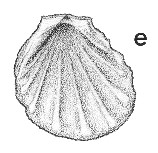
Revised descriptions of New Zealand Cenozoic Mollusca from Beu and Maxwell (1990)

 | Revised descriptions of New Zealand Cenozoic Mollusca from Beu and Maxwell (1990) | 
|
  (Pl. 27e): GS7862, N02/f7554, mouth of Waioha Stream, north shore Parengarenga Harbour, Northland, Otaian (GNS) |
Beu & Maxwell (1990): Chapter 12; p. 243; pl. 27 e.
Synonymy: Pecten zitteli Hutton 1873b, p. 32; P. (Amusium) zitteli; Parvamussium zitteli
Classification: Propeamussiidae
Description: Moderately large for family (height 20-30 mm), little-inflated, subcircular to oval, typically higher than long. Ears relatively small, subequal, no byssal notch. Exterior smooth except for very fine commarginal ridges. Interior with 8-10 prominent radial costae, in many specimens reaching only 0.67 distance across disc. Each ear with prominent auricular crus at base.
Comparison: The status of Propeamussium papakurense (Otaian, Papakura, Auckland) is uncertain (Beu 1970c, p. 214) — it may be a synonym of P. zitteli. However, because of the great fragility of specimens of Propeamussium and because much fossil material consists of steinkerns (internal moulds), it is very difficult to know how many species are represented and whether P. zitteli really has the very long stratigraphic range adopted here. P. zitteli was assigned to Parvamussium Sacco, 1897 by Marwick (1928, p. 452) but the oval shape and the absence of a byssal notch indicate that it belongs in Propeamussium (Maxwell 1988a, p. 44). On the other hand, the generally much smaller, internally ribbed species that Marwick (1928, p. 452) assigned first to Variamussium Sacco, 1897 and later (Marwick 1931, p. 64) to Ctenamusium Iredale, 1929 are of more nearly circular shape and have a well developed notch, and belong in Parvamussium (Maxwell 1988a, p. 44). Species of Parvamussium typically have more prominent external sculpture than those of Propeamussium. This entire family is diverse but poorly understood in New Zealand, and is greatly in need of revision.
Although Propeamussium and Parvamussium superficially resemble internally ribbed pectinids such as Amusium, they differ sufficiently from the Pectinidae in anatomy and shell structure to warrant inclusion in a separate family Propeamussiidae (Waller 1972). Pectinids are most common in depths of less than 200 m (although some species occur as deep as 6000 m) whereas propeamussiids are rare in depths less than 60 m and are most common below 150 m. The most dramatic difference between Pectinidae and Propeamussiidae, however, is in feeding habits — the former are suspension feeders, whereas the latter are carnivores living on small crustaceans (mostly copepods and ostracodes) (Knudsen 1967, p. 327-329). Hicks & Marshall (1985) demonstrated that bathyal propeamussiids capture male copepods to the exclusion of females, greatly influencing the sex ratio of the copepods, and suggested that propeamussiids have mantle-margin luminescent organs with which they lure male copepods seeking luminescent females.
Distribution: Whaingaroan-Tongaporutuan(?); Whangape Lake, Waikato district, Whaingaroan (type); numerous localities throughout New Zealand, mainly in siltstone or mudstone.
Cite this publication as: "A.G. Beu and J.I. Raine (2009). Revised
descriptions of New Zealand Cenozoic Mollusca from Beu and Maxwell (1990). GNS
Science miscellaneous series no. 27."
© GNS Science, 2009
ISBN
978-0-478-19705-1
ISSN 1177-2441
(Included with a PDF facsimile file
copy of New Zealand Geological Survey Paleontological Bulletin 58 in CD version
from: Publications Officer, GNS Science, P.O. Box 30368 Lower Hutt, New
Zealand)